10 Cake Secrets Professional Bakers Don’t Want You to Know
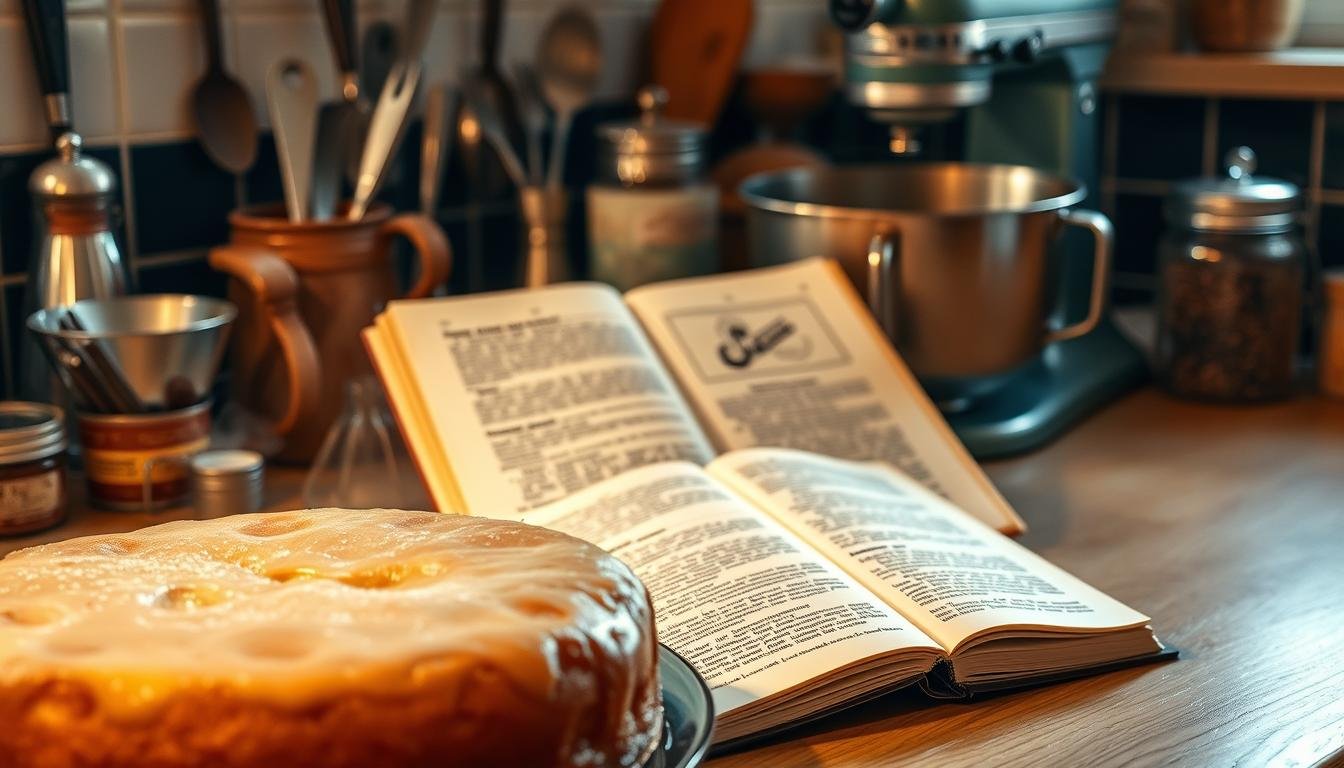
Have you ever looked at a beautifully decorated cake and felt a little jealous? I know the feeling. When I started baking, I wanted my cakes to be as light, moist, and pretty as those in bakeries.
I tried many times and had lots of failures. But I found out pros have some baking secrets. They turn simple ingredients like flour, eggs, and sugar into stunning cakes.
If you want to amaze your friends or enjoy a perfect slice, I have some tips for you. These tips have helped me bake amazing cakes. Let’s learn how to bake the perfect cake together!
Key Takeaways
- Mastering ingredient temperatures is crucial for cake perfection.
- Understanding the roles of each ingredient transforms your baking.
- Avoiding common mixing errors elevates your cake quality.
- Knowing the right flour to use can impact texture and taste.
- Egg freshness and size are more important than you think.
- Moistness can be achieved with simple syrup, yogurt, or vegetable oil.
- Proper oven calibration ensures even baking.
The Science Behind Cake Baking
Baking a cake is like a science magic show. You mix ingredients, and poof—a cake! Knowing how each part works is key to a yummy, fluffy cake. So, let’s see how each ingredient helps in making a cake everyone loves.
Understanding Ingredients and Their Roles
First, getting the ingredients right is super important. Flour makes your cake strong, and sugar makes it sweet and brown. Did you know room temp butter and eggs mix better? They help your cake puff up perfectly. It’s these little things that can turn a good cake into an amazing one!
| Ingredient | Function |
|---|---|
| Flour | Provides structure |
| Sugar | Sweetens and aids browning |
| Butter | Adds flavor and helps trap air for rising |
| Eggs | Bind ingredients and add moisture |
The Importance of Temperature
Temperature plays a huge role in cake baking. Using ingredients that are room temp helps them mix better. This gives you a cake that’s just right. Also, your oven needs to be just the right temp. Too hot, and your cake could flop. Too cold, and it might be too heavy.
Don’t forget to keep your un-iced cake wrapped up in a cool place. This keeps it fresh and tasty. So, for your next cake, remember: use the right stuff and keep things at the right temp for the best bake!
Choosing the Right Flour for Your Cake
When baking a cake, picking the right flour is key. It affects your dessert’s texture. Let’s look at the cake flour versus all-purpose comparison. Each flour type improves your baking in different ways. Knowing which to use can take your cakes to the next level!
All-Purpose vs. Cake Flour
All-purpose flour is a kitchen must-have. It works for many baking projects. But, it has more protein than cake flour. This extra protein is good for breads and muffins. Yet, it might make cakes denser than you’d like.
| Characteristic | All-Purpose Flour | Cake Flour |
|---|---|---|
| Protein Content | 10-12% | 7-8% |
| Texture Effect | Denser, more structured | Softer, finer crumb |
| Ideal For | Bread, muffins | Delicate cakes |

Cake flour has less protein, leading to less gluten. This makes the cake soft and fine. It’s perfect for light, fluffy cakes like angel food or chiffon. Getting to know this cake flour versus all-purpose comparison helps pick the best flour for your cake.
Gluten’s Impact on Texture
Gluten in wheat makes bread chewy. But too much makes cakes dense, not tender. Cake flour’s low protein makes less gluten. So the cake’s texture is lighter and delicate. This is key in different types of cake textures explained.
So, think about the cake texture you want next time you bake. Whether it’s all-purpose or cake flour, knowing about their effects and gluten’s role is vital for cake mastery!
Mastering the Perfect Cake Batter
Creating perfect cake batter is key to baking a great cake! If you’re starting out, learning different cake mixing methods for beginners greatly helps. A good mix means your cake will be even and rise well when baked.
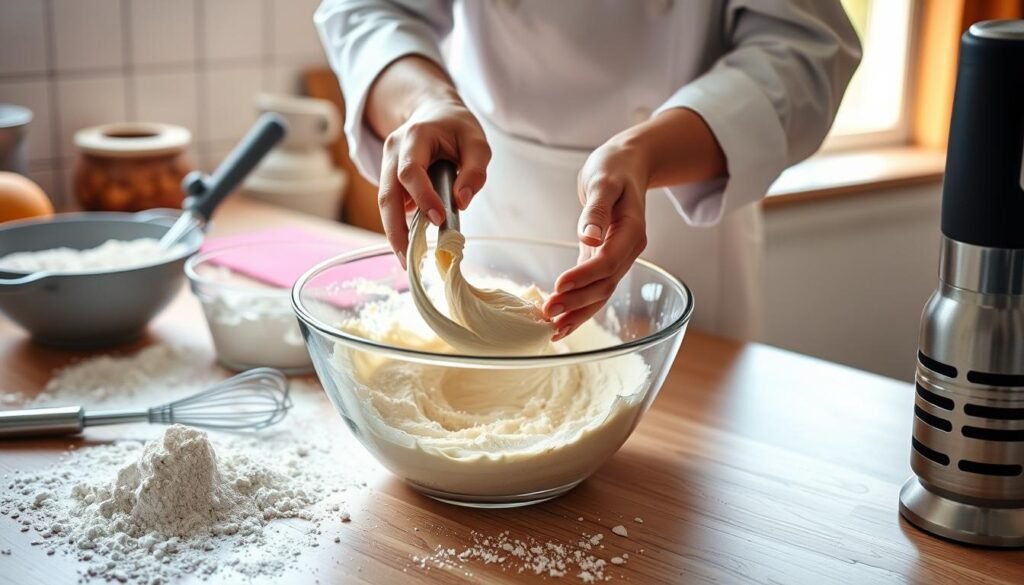
Mixing Techniques for Optimal Texture
The way you mix your batter is very important. For a batter that’s smooth and airy, try the “fold” method. This method lets air in but keeps the batter from falling flat. It’s best for making a cake that’s light and fluffy. A tip from the cake batter ratio perfection guide is to add dry to wet ingredients slowly for a smooth mix.
Avoiding Overmixing Errors
Many beginners mix their batter too much. This can make the cake tough instead of soft. To avoid this, stop mixing when the ingredients are just blended. If you watch how long and how you mix, you can get the batter just right. This advice comes from every cake batter ratio perfection guide out there.
How to Gauge Batter Consistency
It’s not too hard to get your batter’s consistency right. The batter shouldn’t be too thick or too thin. It should slowly flow off the spoon. Following a cake mixing methods for beginners guide helps know how thick your batter should be for each cake type. Getting this right means your cake has a higher chance of turning out well!
The Role of Eggs in Cake Baking
Hey there, fellow home bakers! Ever wondered why eggs are so important in cake baking? Let me tell you—eggs are key players that impact your cake’s success. They help you steer clear of baking mistakes and improve your skills.
Freshness Matters: Why It’s Important
It’s vital to use fresh eggs in cake baking. Fresh eggs give your cake better structure and stability. This is crucial for avoiding a how to prevent cake from sinking center dilemma. Older eggs might not whip well, leading to a dense cake. Plus, fresh eggs make your cakes lighter and fluffier by adding more volume.
Different Egg Sizes and Their Effects
The size of the egg matters in your baking. Larger eggs add more moisture and affect ingredient balance. This balance is key, as explained in cake ingredient temperature importance. If the egg size is off, your batter could be too runny or too thick. This makes for imperfect cakes.
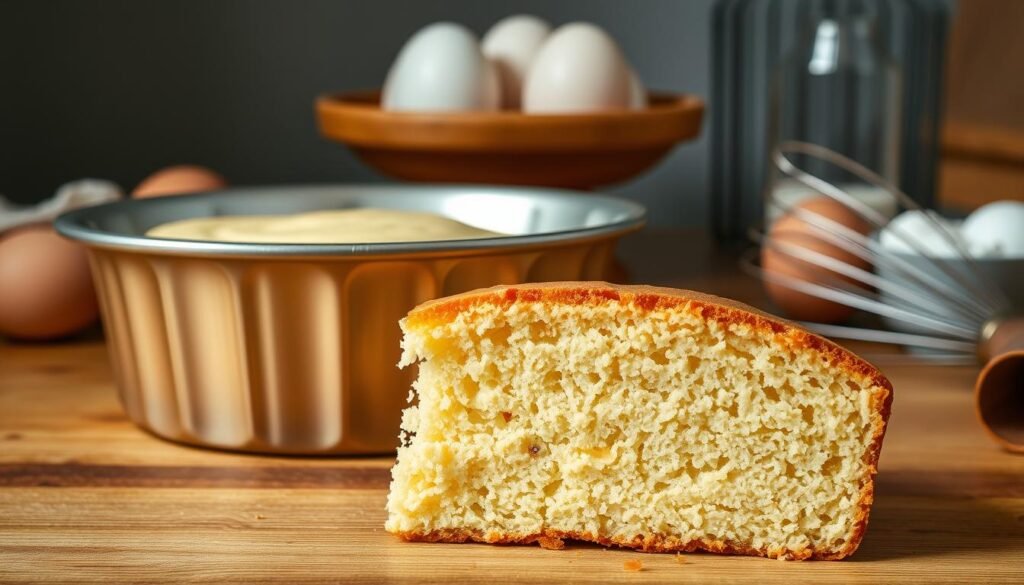
| Egg Size | Volume (Approx.) | Effect on Baking |
|---|---|---|
| Large | 2 oz | Standard for most recipes; optimal moisture balance. |
| Extra Large | 2.25 oz | More moisture; can make batter runnier. |
| Jumbo | 2.5 oz | Much more moisture; can severely affect batter consistency. |
Knowing these details can greatly improve your cake quality. Keep these tips in mind to excel in cake baking!
Secrets to Moist Cakes
We all crave moist and yummy cakes. Luckily, achieving this is easier than you think! Here, I’ll share some awesome cake moisture retention tricks. Professional bakers love these tips. They’ll help you how to keep cake moist overnight. Plus, they add amazing cake flavor enhancing secrets to each bite!
The Magic of Simple Syrups
Simple syrups are a baker’s best secret. Brushing flavored simple syrup on cake layers locks in moisture. It also boosts taste. Imagine a whisper of vanilla or a tang of lemon in every crumb!
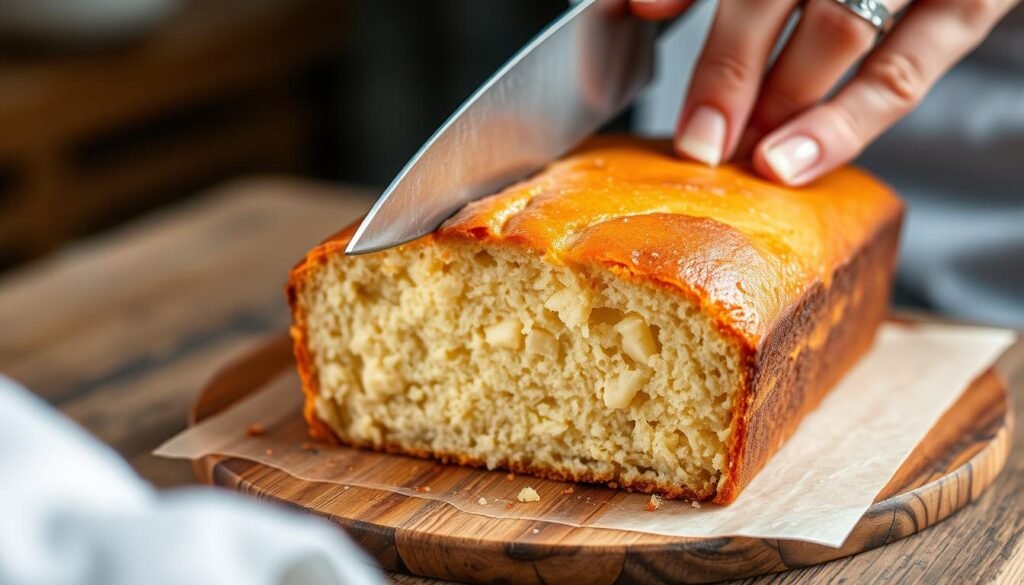
Using Yogurt or Sour Cream
Adding yogurt or sour cream to batter is smart. These add fat and acidity. They make the cake soft and moist. You’ll be amazed at the difference they make!
Experimenting with Vegetable Oil
Use vegetable oil instead of butter for moist cakes. Oil stays liquid at room temperature, keeping cakes tender. This tip is great if you need how to keep cake moist overnight. It keeps the cake’s texture and flavor perfect.
The Art of Cake Leveling
Learning to level a cake makes your homemade ones look pro! You only need simple tips. A perfect cake base is easy.
Tools You Need for Precision
You don’t have to have special tools to level cakes. Just use a long serrated knife and keep your hand steady. Also, a turntable helps a lot. Measure first to cut accurately.
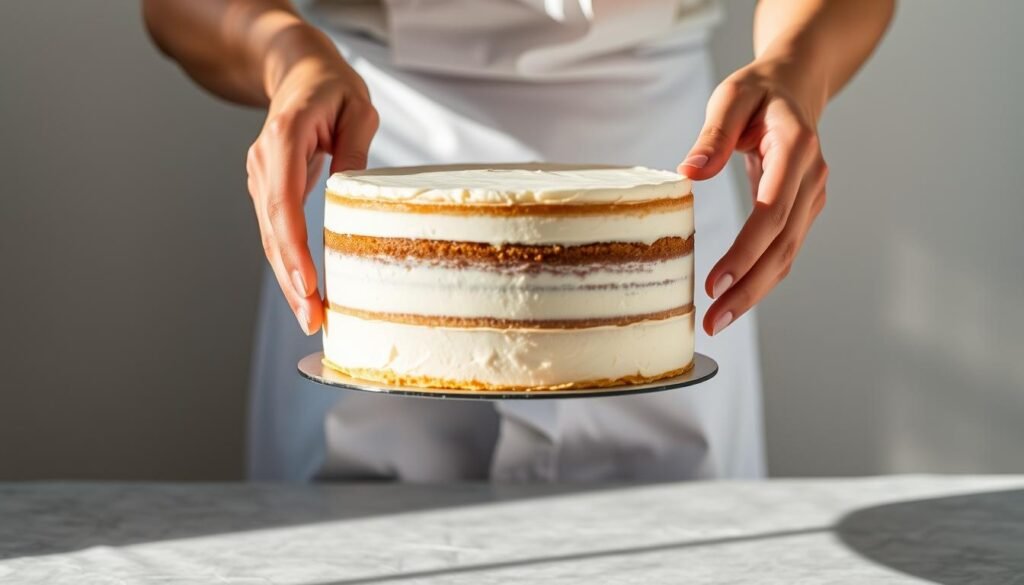
Techniques for Even Slicing
The right technique is key for even slices. First, mark where you’ll cut. It guides your knife smoothly.
When adding layers, be gentle and spread fillings evenly. Take it slow and have fun. It’s enjoyable!
| Tool | Benefits |
|---|---|
| Cake Leveler | Ensures precise, even layers |
| Serrated Knife | Flexible and reliable for straight cuts |
| Turntable | Makes slicing and decorating much easier |
Temperature Control: The Importance of Baking
Have you ever wondered why some cakes get too dry or soggy? Your oven’s temperature might not be accurate. Getting the temperature right is key for fluffy cakes. Here’s how to handle it easily.
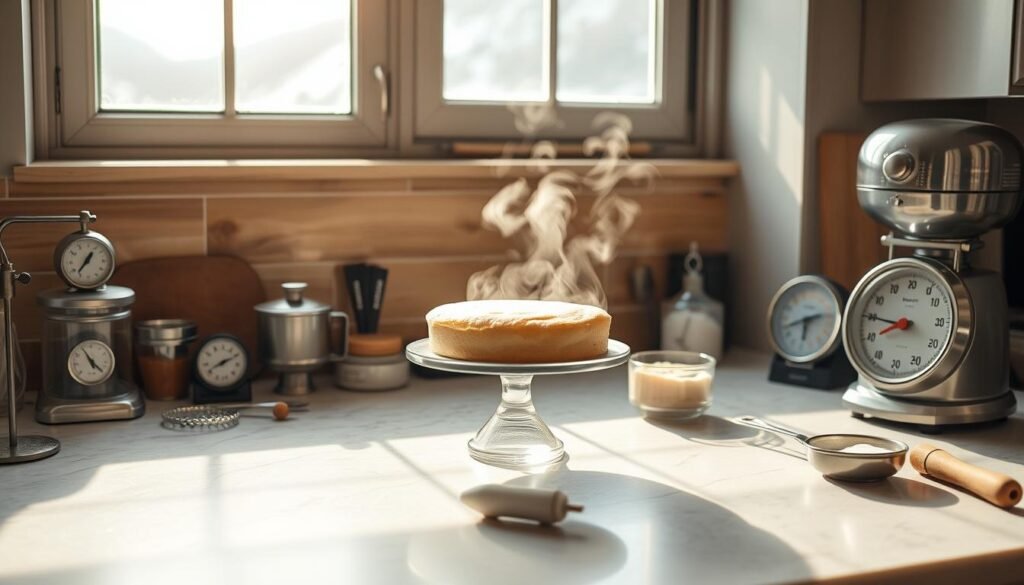
Oven Calibration: Why It Matters
Having your oven calibrated means it bakes at the temp you set. For instance, you set your oven to 350°F, but it’s actually at 375°F. Your cakes can end up overcooked or not done enough. Being exact is even more important when baking at high altitudes.
Using an Oven Thermometer
Use an oven thermometer to check your oven’s real temperature. Put it in your oven’s center to see if the temp is off. I’ve found some older ovens can be off by 25°F! This tool helps you make the needed adjustments, ensuring your baking is on point.
| Scenario | Result |
|---|---|
| Undercooked Middle | Check oven calibration; may be set too low |
| Burned Edges | Oven may be running hot; verify with thermometer |
Cake Decoration Tips from Professionals
Decorating your cake beautifully matters as much as its taste. Whether you’re starting or already a pro, mastering the perfect look is essential. We’ll dive into creating stunning ganache and perfect buttercream.
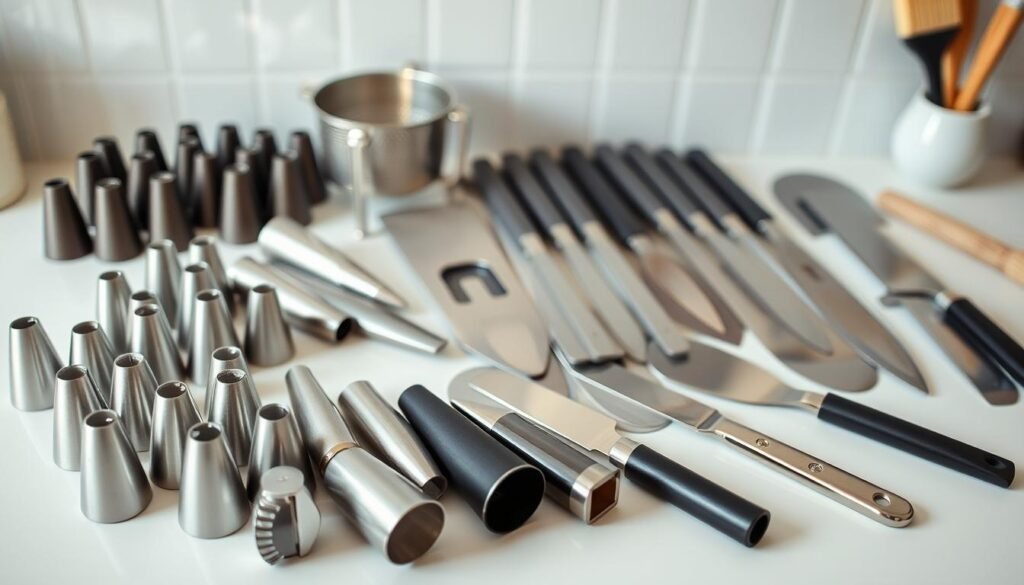
Beautiful Ganache Finishes
Getting a smooth, shiny ganache is easier than it seems. It’s about mixing cream and chocolate right. Start with quality chocolate and fresh cream in equal amounts. Warm the cream till it simmers, not boils, and pour it over chopped chocolate. Wait a minute, then stir until smooth.
Let your ganache cool a bit before covering your cake. Use an offset spatula to spread it nicely. For a sleek finish, tap the cake or turn it on a turntable. This lets the ganache settle smoothly. Remember, knowing how to properly store cake unfrosted keeps the base fresh for decorating.
Perfecting Buttercream Consistency
To nail buttercream, the butter’s temperature is crucial. It should be at room temperature, but not too soft. First, whip the butter until creamy, then slowly add powdered sugar. Mix in a little milk or cream and vanilla for the perfect texture.
If your buttercream is too hard, add more liquid by the teaspoon. If it’s too soft, add more powdered sugar. For beginners, practice with piping bags for different designs. Using an offset spatula helps spread the buttercream smoothly. This makes your buttercream not just tasty, but looks good too.
Here’s a quick cheat sheet to improve your cake decorating skills:
| Decoration Method | Key Tools | Tips |
|---|---|---|
| Ganache | Offset Spatula | Use a turntable for even coverage |
| Buttercream | Piping Bags | Keep butter at room temperature |
Trending Cake Flavors to Try
Exploring cake flavor enhancing secrets is fun for anyone who loves baking! Try gourmet combos for new, exciting tastes. These combos can make your taste buds happy with fancy flavors.
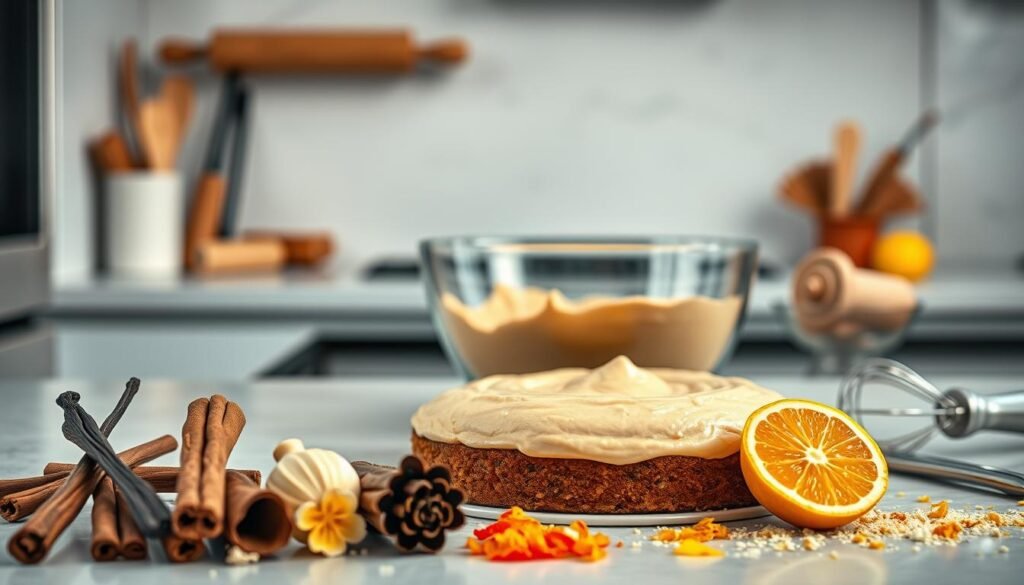
Gourmet Combinations
How about mixing salted caramel with apple? It’s a great mix of sweet, salty, and fruity. Or, mix exotic spices like cardamom with dark chocolate. This mix creates amazing flavors that everyone will remember.
Classic Flavors with a Twist
Adding a new twist to classic flavors is cool. Like adding tangy lemon curd to a vanilla cake. It changes a common flavor into something special. This mix makes your cakes stand out more.
So, try these yummy cake flavor enhancing secrets. Your next time baking could be the most fun and rewarding ever!
Common Baking Mistakes and How to Avoid Them
Baking a perfect cake can be tricky, even for the pros! Let’s explore common mistakes and avoid them with our cake baking troubleshooting guide!
Identifying Underbaking Issues
There’s nothing worse than a soggy center in a cake that looks done. Underbaking is often to blame. Try the skewer test: if it comes out clean, your cake is ready. If not, it needs more oven time. This old-fashioned trick always works wonders, according to any cake baking troubleshooting guide.
Troubleshooting Cake Collapse
Ever seen your cake sink in the middle when you check it? This sinking issue confuses many bakers. Learning how to prevent cake from sinking center is key. Don’t open the oven door too soon; it lets in cold air and messes up the cake. Too much baking powder can also cause your cake to fall. Right measurements and steady oven temperature help cakes stay up.
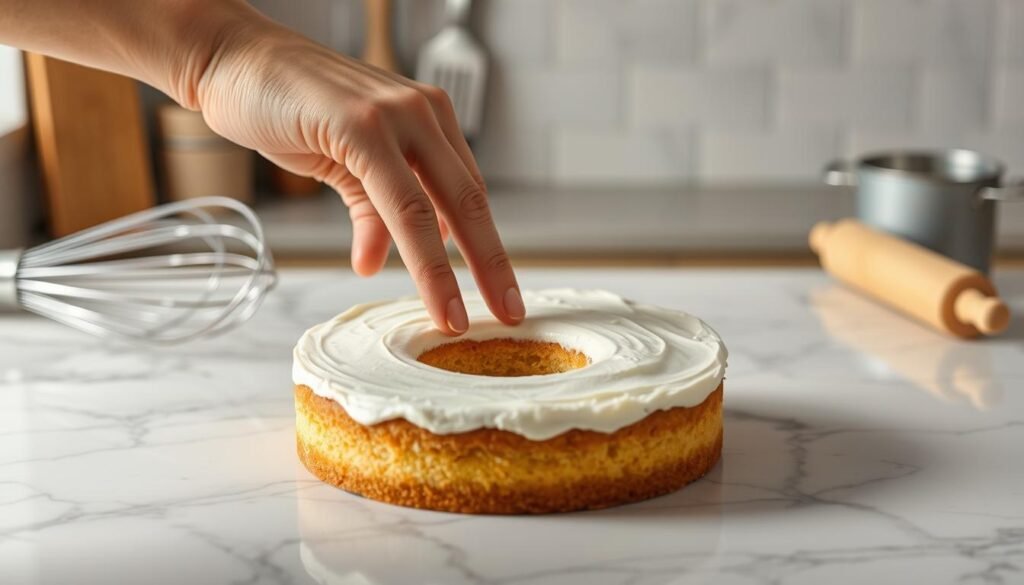
Tips for Storing and Transporting Cakes
Keeping your cakes fresh is important. Proper storage keeps your chocolate or vanilla cakes at their best. For cakes stored at room temperature, use airtight containers. Remember, cakes with cream cheese or fresh fruit need refrigeration.
Best Practices for Freshness
Want your cake to stay delicious days after baking? The key is tight storage. Wrap an unfrosted cake in plastic and put it in an airtight container. It’ll stay yummy for a week. A slice of bread inside helps keep it moist!
Packing for Travel Without Damage
Moving a cake can be easy with the right steps. Make sure your cake stays put while you move. Use a snug cake box and non-slip mats. A bit of bubble wrap adds protection. Keep your cake flat in the car to stop tilts or falls. Enjoy baking!